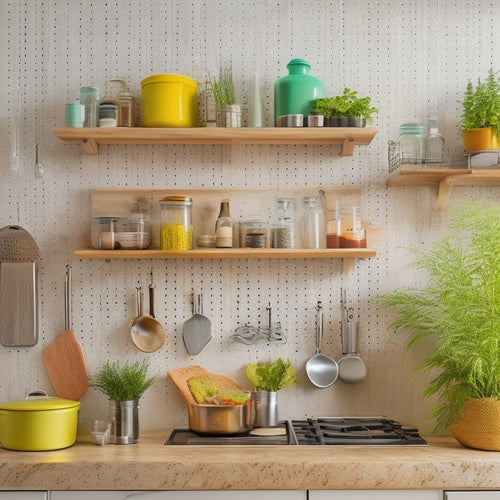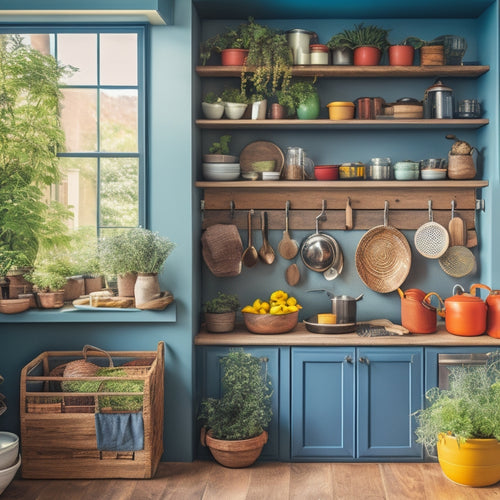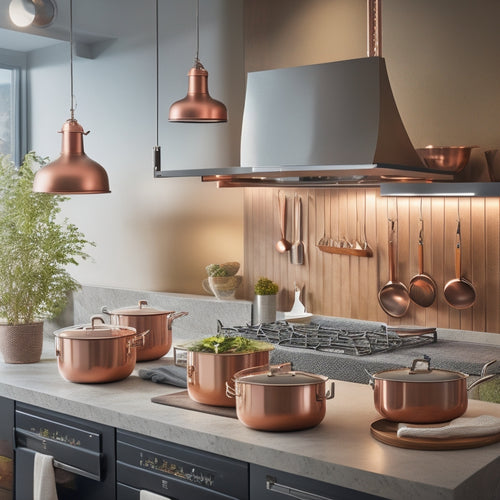
Smart Meal Prep and Storage for College Students
Share
As a college student, you need a smart meal prep and storage strategy to balance classes, assignments, and social activities while maintaining a healthy diet. To get started, invest in compact, leak-proof containers with dividers and airtight seals to keep food fresh. Plan meals in advance, make a grocery list, and opt for simple one-pot dishes to save time and money. Utilize space-saving solutions in your dorm room, such as stackable containers and hanging organizers, to store meal prep essentials. By prioritizing healthy recipes, portion control, and efficient storage, you'll be well on your way to fueling your college life. Now, discover how to take your meal prep game to the next level.
Key Takeaways
• Invest in compact, leak-proof containers with dividers and compartments for efficient meal prep and storage.
• Plan meals in advance and make a grocery list to avoid last-minute takeout and save money.
• Utilize space-saving solutions like stackable containers, hanging organizers, and compact cookware to maximize dorm room storage.
• Prioritize quick and healthy recipes that fit your busy college schedule, focusing on planning and portioning balanced meals.
• Measure and divide food portions using cups, spoons, or a food scale to prevent overeating or undereating and save time.
Essential Containers for College Life
As you navigate the busy world of college life, having the right containers is essential for efficient meal prep and storage. Investing in a few essential pieces will make all the difference in keeping your food fresh and your schedule on track.
Compact containers are a must-have for college students, as they take up minimal space in your dorm room or apartment. Look for containers that are specifically designed for meal prep, with dividers and compartments to keep your food organized and easy to grab on the go.
Leak-proof options are also a must, especially if you're planning to store soups or sauces. You don't want to risk spilling a mess in your backpack or fridge, and leak-proof containers will give you peace of mind.
Additionally, consider containers with airtight seals to keep air out and freshness in. By investing in a few high-quality, compact, and leak-proof containers, you'll be able to meal prep like a pro and keep your food fresh and healthy all semester long.
Meal Prep on a Budget
You don't have to break the bank to meal prep like a pro, and with a few simple strategies, you can create healthy, delicious meals on a college student's budget.
Start by planning your meals in advance, which will help you avoid last-minute takeout and reduce food waste. Next, make a grocery list and stick to it when you're shopping. Buy in bulk and opt for affordable protein sources like beans and eggs.
When it comes to recipe ideas, look for simple, one-pot dishes that can be stretched over several meals. You can also repurpose leftovers to create new meals.
Effective time management is key to meal prep success. Set aside one day a week to prep your meals, and consider cooking in bulk to save time during the week.
Maximizing Dorm Room Storage
College students often face the challenge of storing their meal prep containers and cooking essentials in cramped dorm rooms, but with a few strategic storage solutions, they can maximize their limited space. You can start by utilizing space-saving solutions like stackable containers, collapsible silicone storage bins, and hanging organizers that can be attached to the back of a door or wall. These creative organization ideas will help keep your meal prep supplies within easy reach while keeping your dorm room clutter-free.
When it comes to dorm friendly storage, consider investing in compact, multi-functional items like a microwave-safe cookware set or a portable cooking utensil set that can be easily stowed away in a small cabinet or drawer. By maximizing small spaces, you'll be able to store everything you need to prep healthy meals without sacrificing precious floor space.
Healthy Eating Made Easy
With a well-stocked dorm room and strategic storage solutions in place, it's time to focus on the actual meal prep process, where planning and portioning healthy ingredients can make all the difference in maintaining a balanced diet. You'll want to prioritize quick recipes that can be prepared in no time, while also incorporating time-saving strategies to make the most of your busy college schedule.
Here are some healthy meal prep ideas to get you started:
| Meal | Prep Time | Cook Time |
|---|---|---|
| Overnight oats | 5 minutes | 0 minutes |
| Quinoa salad jars | 10 minutes | 10 minutes |
| Grilled chicken and veggies | 15 minutes | 20 minutes |
| Lentil soup | 20 minutes | 30 minutes |
| Breakfast burritos | 10 minutes | 5 minutes |
Portion Control for Success
Controlling portion sizes is essential to maintaining a balanced diet, as it helps regulate calorie intake and prevents overeating or undereating.
As a college student, you understand the importance of meal planning and time management in your busy student lifestyle. To achieve nutrition balance, you need to master the art of portion control.
Start by measuring your food portions using cups, spoons, or a food scale. This will help you develop a sense of appropriate serving sizes.
When cooking, divide your meals into individual portions and store them in containers. This approach will prevent you from consuming too much or too little food. Additionally, it will save you time during the week when you're short on time.
Labeling and Organization Tips
You'll want to allocate a home to each meal prep container by labeling and organizing them in a way that fits well with your lifestyle. This will guarantee you can easily locate what you need and avoid wasting time searching for containers or ingredients.
Implement a color-coding system to categorize your containers by meal type, such as breakfast, lunch, or dinner. This visual system will help you quickly identify which container holds which meal.
In your fridge, designate specific zones for different types of food, like a 'cook-ahead' zone for meal prep containers and a 'snack' zone for quick grabs. Use pantry labeling to keep track of your dry goods and canned items. Label each shelf or bin with its contents, making it easy to find what you need for meal planning.
Frequently Asked Questions
Can I Reheat Meal Prep Containers in the Microwave?
"Absence of evidence is not evidence of absence," so don't assume your meal prep containers are microwave-safe. When reheating, follow tips like covering containers and using short intervals; prioritize safety precautions.
How Do I Keep Food From Getting Stale or Soggy?
To keep food fresh and prevent staleness or sogginess, you'll want to use air-tight containers that lock in freshness and store them in the refrigerator to maintain ideal refrigeration and moisture control.
Are There Any Meal Prep Ideas for Picky Eaters?
When catering to picky eaters, you can try creative substitutions and customizable options to tailor meals to their tastes. Add fun presentation and appealing aesthetics to make mealtime engaging and enjoyable for them.
Can I Use Glass Containers in the Dorm Room Freezer?
You're wondering if glass containers are safe in the dorm room freezer, coincidentally, just like me when I first started meal prepping! Glass is a great alternative to plastic containers, which can be prone to freezer burn and chemical leaching.
How Often Should I Clean and Sanitize My Containers?
You should clean and sanitize your containers every 1-2 weeks, or immediately after noticing residue buildup, to maintain their lifespan; wash with soap and hot water, then sanitize with vinegar or a dishwasher to prevent bacterial growth.
Related Posts
-

Stylish Pegboard Storage for Open Kitchen Concepts
Stylish pegboard storage can completely enhance your open kitchen concept, merging practicality with contemporary fla...
-

Over-The-Door Kitchen Rack Installation Tips
To install an over-the-door kitchen rack effectively, start by measuring your door's clearance to guarantee a proper ...
-

Ceiling-Mounted Pot Racks for Professional Chefs
Ceiling-mounted pot racks are revolutionary for professional chefs like you. They make use of vertical space, keeping...


